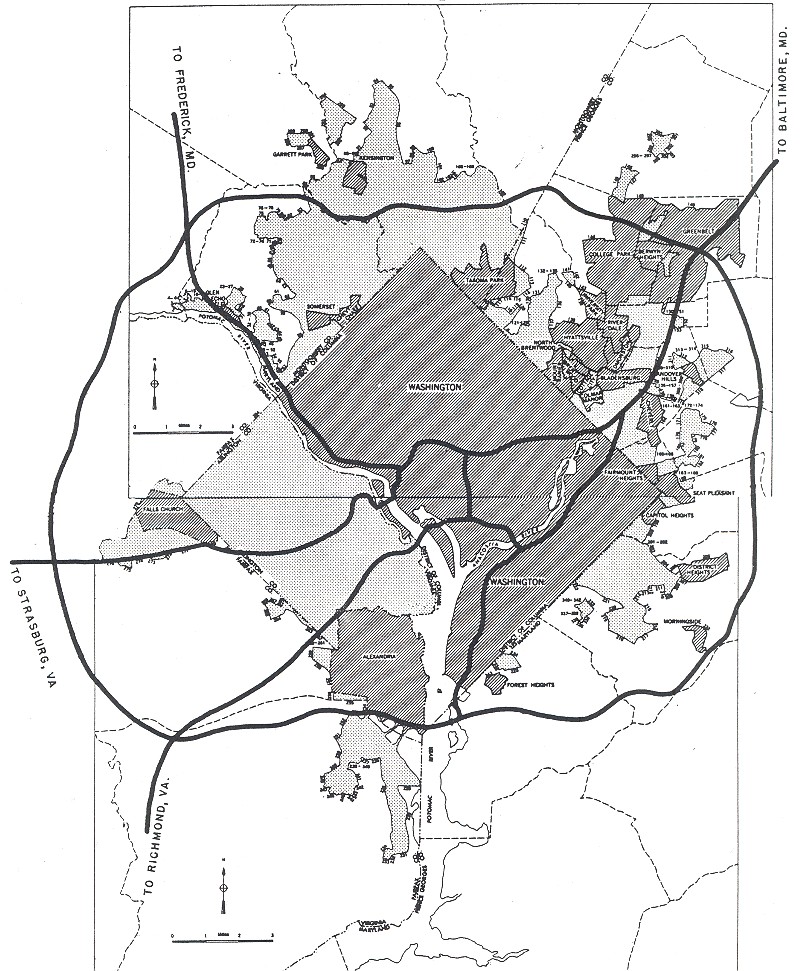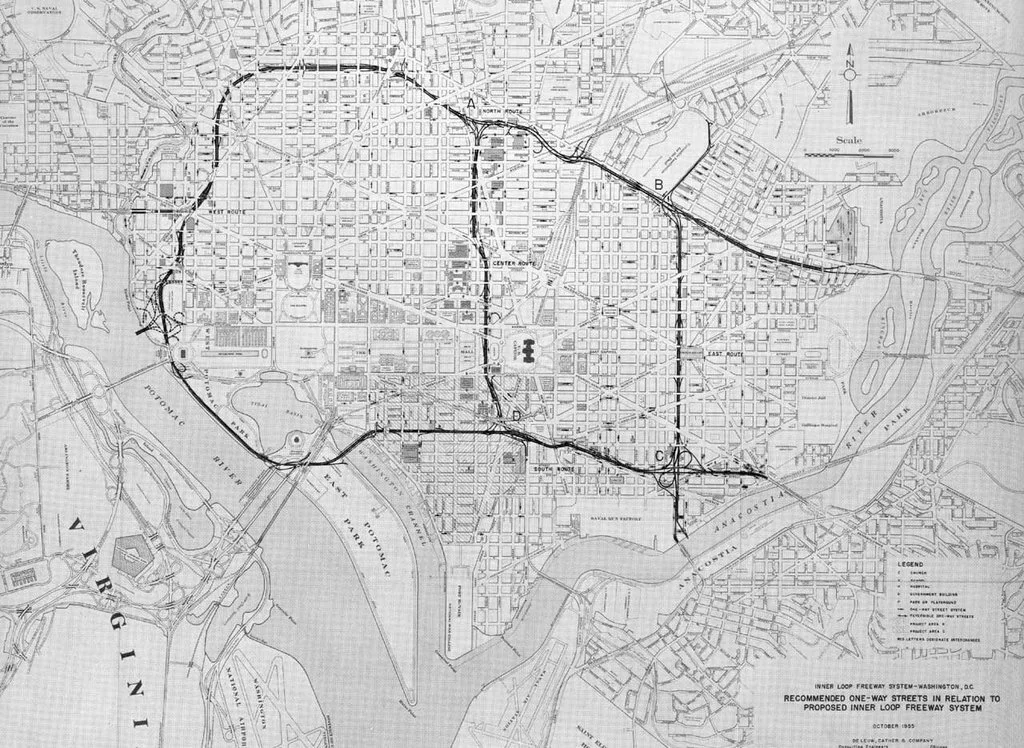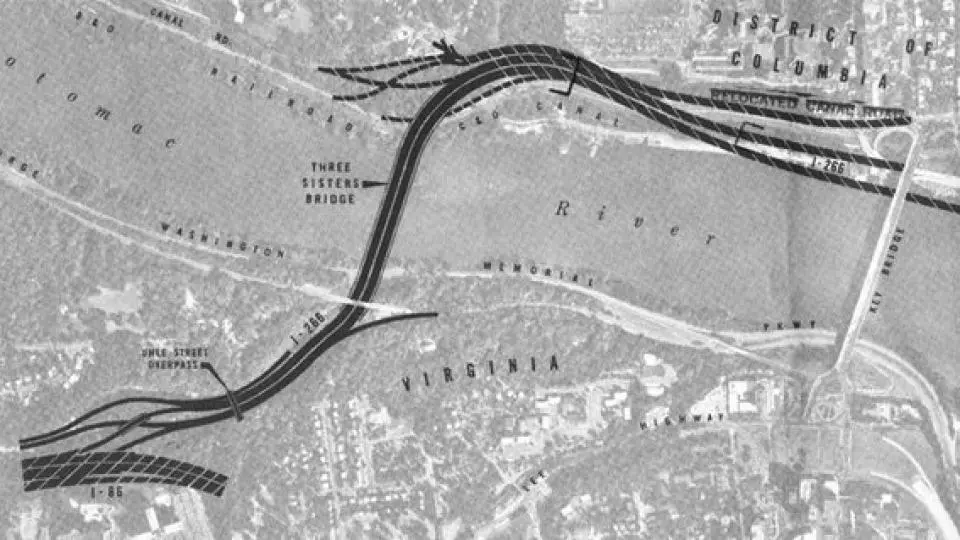For the end of 2018, we conclude with a post on the nation’s capital. With the recent announcement of Amazon.com planning to build new headquarters in Crystal City, Virginia, local citizens and officials have questioned whether the transportation system of Washington, D.C. can handle the increased load on its system. The D.C. Metro has been criticized for years — with many residents of the area arguing that the iconic subway/local rail system is not far-reaching and comprehensive enough to meet the needs of many commuters.

The history of the D.C. Metro is also intertwined with the history of the freeway system in the nation’s capital — namely, that some of the Metro lines were built along corridors where Interstate highways might have run. Critics might argue that Washington D.C. has the worst of both worlds: an inefficient, incomplete rail system combined with an inefficient, incomplete expressway system. Whether you commute by car or without a car in D.C., you’re likely to run into hassles and headaches.

If you want to live in Washington D.C., you better get used to a busy commute!
What makes Washington so unique from every other city in the United States, besides being the seat of the federal government? A lot of it has to do with the transportation system. Much of the planning for the city’s original layout was borne from the mind of one man, a French military engineer by the name of Pierre L’Enfant (1754-1825). L’Enfant had a logical plan for the layout of the District of Columbia: streets that ran north-south would have a number (1st, 2nd, 3rd, etc.) while streets that ran east-west would have a letter (A Street, B Street, etc.). Streets that ran in a diagonal manner would be christened as as avenue with one of the state names (Pennsylvania Avenue, New York Avenue, etc.) You can read more details of this plan in a fascinating article at curbed.com here.
All very sound and orderly, but when it came time for Washington, D.C. to come up with its own freeway plan in the mid-1900s, the process was anything but. Numerous changes and revisions were made, and to this day, much of the D.C. freeway system, especially around the downtown areas, lies in bits and pieces.

Plans from 1955 Yellow Book

1958 Plans

1971 Plans
While it isn’t possible to cover all the canceled/altered/abandoned highway projects in one post, here are some of the more notable ones:
I-95:
Currently I-95 runs along the eastern half of the I-495 beltway, but this was not the original plan. As we saw with I-40 in Memphis, I-95 was to have made a direct cut through the city. The original plan (coming up from the south) was for I-95 to cross the beltway, travel the entire length of I-395, and then turn northeast, eventually merging with the College Park/I-495 beltway interchange. The “Northeast Freeway” had several different proposed routes. The latest one, from the early 1970s, would have had I-95 as an eight-lane freeway running through the North East sector of the city along the Pepco power line and B&O Railroad corridors. You can see evidence for the continuation of I-95 inside the beltway by the “over-engineered” interchange at College Park, which takes south-bound drivers to a Park and Ride on the Metro Green Line:

I-70S:
part of the proposed North Central Freeway. Before 1975, I-270 in Maryland was designated I-70S. While it currently terminates at the northwest corner of the I-495 beltway in North Bethesda, plans existed to extend the freeway into D.C. itself. Originally the freeway was to run along the same route as Canal Road and the Clara Barton Parkway before meeting up with I-66. The proposed route was then changed, with I-70S traveling along the I-495 beltway before turning south near Takoma Park, eventually merging with then-proposed I-95 In the North East part of D.C. The freeway was to be six lanes and travel parallel with the B&O railroad, with a cleared right-of-way. Residents of D.C. and Takoma Park stridently and occasionally violently opposed the highway, concerned over proposed demolitions in the Woodside Park and Sligo Creek Park neighborhoods. The proposed highway was abandoned in the early 1970s.
I-66:
Also known as the North Leg Freeway. Up until the 1970s, plans existed to extend I-66 eastward by 1 1/2 miles from its current terminus at U.S. 29 and K Street. I-66 was to have run via tunnel underneath K Street before emerging at ground level to merge with I-95 (currently designated I-395) near New York Avenue.

Map of the proposed I-66, I-95, and I-295 extensions in the central part of D.C.

A slightly modified proposal showing more detail.
I-266:
Interstate 266 was to have been a short connecting freeway running much of its length along the Potomac River. The western terminus was supposed to have been where Sprout Run Parkway crosses I-66 in Arlington, Virginia. From there, I-266 was to run along the current route of Sprout Run, cross over the Potomac along the proposed Three Sisters Bridge, and then turn east, running along Canal Road NW before merging again with I-66 near Rock Creek and Potomac Parkways and K Street. Strong, and occasionally violent protests against the planned Three Sisters Bridge during the 1960s and 1970s caused the I-266 plan to be abandoned. The only segment of the proposed freeway to see completion became known as the Whitehurst Freeway (U.S. Route 29), which runs for approximately 0.8 miles.

Proposed route for the western segment of I-266.

An artistic rendering of the proposed Three Sisters Bridge in Arlington.
I-295:
Also known as the Anacostia Freeway. Originally intended to follow the route of I-695 and become part of the “Inner Belt” in downtown D.C. Other proposals had the interstate running along D.C. Route 95.
I-695:
Interstate 695 is only two miles long, but there were plans to extend the highway further east as well as west. During the 1960s proposals were made to extend I-695 west, which would have brought it in the vicinity of the Washington Monument and Lincoln Memorial along Maine and Independence Avenues, before terminating at I-66 near the Constitution Avenue interchange:

In the 1990s another proposal was made, this time to extend the freeway east along Southeast Boulevard, eventually merging with D.C. Route 295. The goal was to relieve congestion on the heavily-traveled John Philip Sousa Bridge.

Southeast Boulevard exiting off to Pennsylvania Avenue. The highway at left, which runs under the Penn. Avenue overpass to RFK Stadium, was originally intended as an eastern extension of I-695.
I-595:
Interstate 595 was originally conceived as a spur freeway linking I-395 with Reagan National Airport in Arlington. It was to have followed the same path as current U.S. Highway 1. The route was never upgraded to Federal Interstate Highway standards.

Wikimedia map showing some of the various highway proposals for Washington D.C. during the 1950s – 1970s.
With the advent of Amazon.com coming to town, it will be fascinating to watch the city’s debate over transportation continue and what plans will be approved going forward.
Thanks to all you great readers for an exciting journey here in 2018! Rest assured, there will be much more to post in the new year!
Additional Sources:
https://commons.wikimedia.org/wiki/File:DC_freeway_map.svg
https://www.fhwa.dot.gov/highwayhistory/data/page05.cfm
https://en.wikipedia.org/wiki/Washington_Metro
https://dc.curbed.com/2014/8/13/10061100/facts-and-myths-about-dcs-street-system
http://www.vahighways.com/route-log/i266.htm
http://wwwtripwithinthebeltway.blogspot.com/2007/03/georgetowns-waterfront-freeway.html
https://en.wikipedia.org/wiki/North_Central_Freeway_(Washington,_D.C.)
https://en.wikipedia.org/wiki/Interstate_270_(Maryland)#History
https://en.wikipedia.org/wiki/Interstate_66#District_of_Columbia_2
https://en.wikipedia.org/wiki/Northeast_Freeway_(Washington,_D.C.)
http://wwwtripwithinthebeltway.blogspot.com/2007/04/1971-dc-b-i-70s-i-270-takoma.html
http://www.fosc.org/NCFreeway.htm
http://www.dcroads.net/roads/southeast/
Good article. I can remember the “Beltway” back in the late 1970s while an undergrad in the DC area.
LikeLike
Thanks, Larry! I traveled with family in D.C. in 1986, when I was just a kid. I-495 and I-395 were real busy back then. I can’t imagine what it’s like now!
LikeLiked by 1 person